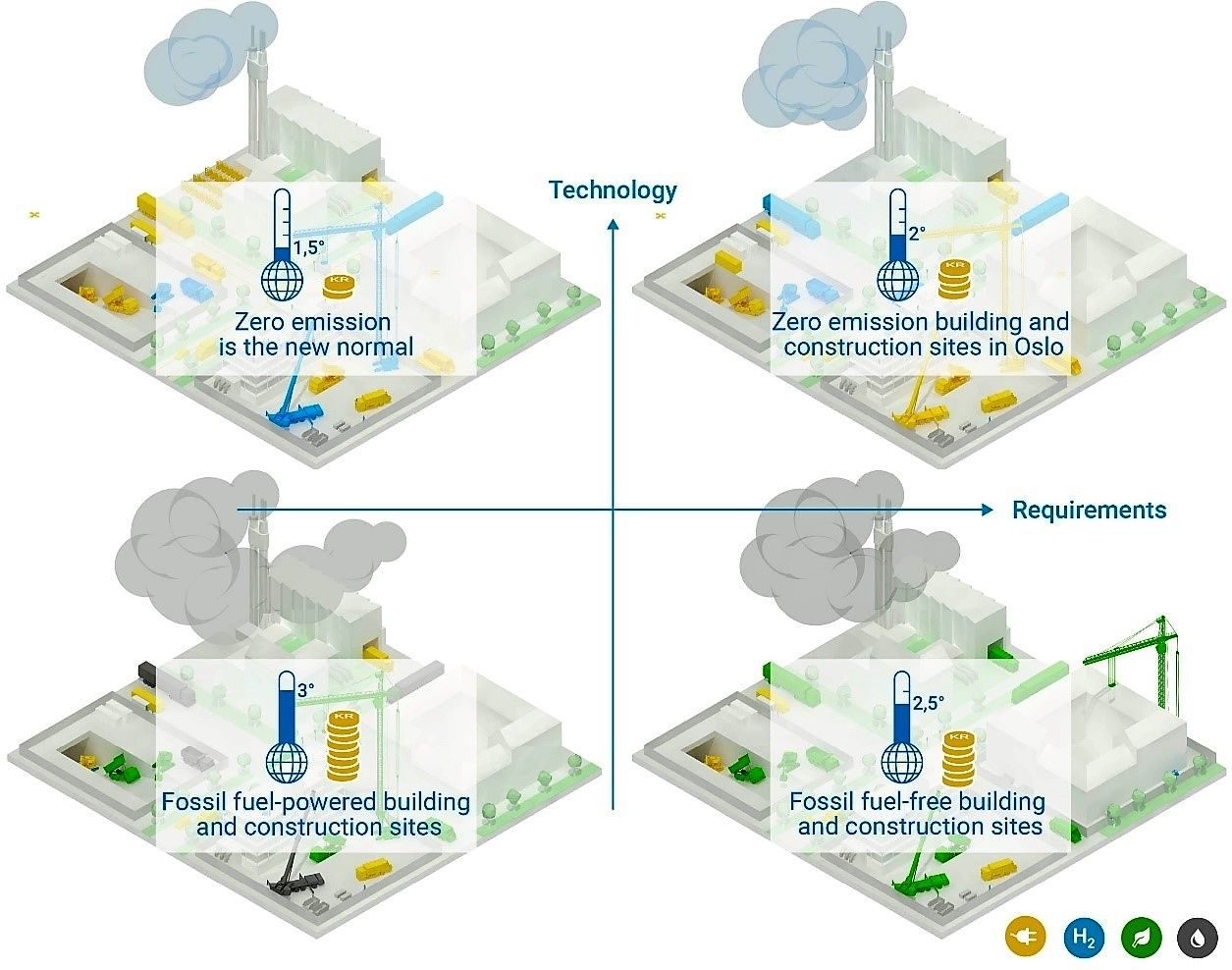

Takk for din påmelding.
Du vil nå regelmessig motta nyheter om Oslo.
Ha en fin dag :)
Hilsen oss i Oslo kommune
The goal of the City of Oslo is that building and construction activities in Oslo shall be zero emission by 2030. From 2025, building and construction work carried out on assignment for the City of Oslo shall be zero emission. This impact assessment is based on quantitative analysis of energy and power requirements, cost increases, wealth creation and employment, as well as qualitative methods to describe the market prospects. The objective has been to examine changes in energy and power consumption, costs, and other consequences of the transition to zero emission building processes in Oslo, as well as to describe future scenarios in the period up to 2025 and 2030.
The analyses connected with energy and power consumption are based on energy consumption data from some of the first zero emission building and construction sites in Oslo. A selection of building and construction projects has been scrutinised with respect to how energy requirements vary, depending on differences in work processes and different types of construction machinery and means of transport. This has been carried out for two theoretical scenarios: a fully electrified building site and a fully electrified construction site.
The results demonstrate that the most energy-demanding construction phase is groundwork, followed by superstructure and demolition. The energy consumption of construction machinery is within the available power rating, and by making some adjustments to charging breaks and technology type (battery, cable or cable/battery), the power issues presented by the construction machinery are resolved according to our calculations. This becomes a greater challenge if one is also to have enough available power for charging vehicles, since charging of external transport does not at present take place at building and construction sites, and few facilities exist for charging heavy transport vehicles.
Analyses have also been carried out for three alternative scenarios: a reference, an average and an optimised scenario. The results have been used to create a projection of the energy requirements for zero emission building and construction sites in the City of Oslo in the years up to 2030 for two different scenarios (reference and development), assuming rapid and gradual implementation rates. The results show that the future energy demand for zero emission building and construction sites in the City of Oslo will be in the order of 77-97 GWh. Since at present only a small number of building and construction sites in Oslo use electricity, this can result in an increase in energy requirements of 77-97 GWh between now and 2030.
In connection with the cost analyses, estimates of lifetime costs were prepared for a small (8-16 tonne), a medium (16-23 tonne) and a large (>23 tonne) excavator, and for a tipper truck without a trailer and a tipper truck with a trailer with a maximum permitted total weight of 27 tonnes. The smallest construction machinery units (under 8 tonnes) are not included in this cost analysis. Such machines are assumed to represent a small percentage of greenhouse gas (GHG) emissions and are already more readily available in the market with approximately competitive lifetime costs. Lifetime costs have been compared for diesel, hydrotreated vegetable oil (HVO) and electric alternatives, and analyses show that the electric alternative involved higher initial investment costs but lower operating costs over its lifetime.
Depending on energy prices, the lower operating costs could mean that the price of the electric alternative is competitive over an analysis period of five to six years. Based on the lifetime costs and energy requirements, an assessment was carried out of what the additional costs for a building and construction site may be in 2022, 2025 and 2030. The results indicate that additional costs will probably be accrued through a transition to zero emission building and construction sites for some time but that in some cases break-even, or even reduced costs, may be achievable, approaching 2030.
Dialogue with market operators has been carried out in the form of interviews, workshops, and questionnaires. The most positive respondents believe that the City of Oslo will achieve the goals set for 2025 and 2030, with a few exceptions. Few believe that it will be possible to achieve the 100% zero emission goal by 2030, since there are still many types of construction machines that have not yet begun the transition to zero emission operation.
Several major manufacturers have commenced mass production of smaller construction machines (under 8 tonnes), but machines over 8 tonnes are only specially produced in smaller numbers. As a rule, it takes two to three years from the introduction of a machine until it is commercially available. Many models will therefore not be ready for sale in 2025. Some believe that it is within the bounds of possibility that almost the entire market share (new investments) in Oslo will be zero emission by 2030. These operators expect that even in 2030 there will be a need to use diesel-based machinery and vehicles but with sustainable biofuel (HVO100). The market dialogue also showed that there is broad agreement that the transition to zero emission building and construction sites requires expansion of the supply grid, both for district heating and for electricity, and that infrastructure for charging large vehicles must be in place.
Based on the energy and power analyses, cost analyses and market dialogue, four potential future scenarios have been drawn up for zero emission building and construction sites in Oslo in 2030. The main sources of uncertainty that form the basis of these scenarios are the degree of technological development and strict/effective requirements from the City of Oslo. Measures for achieving the various scenarios are not considered but highlight important driving forces that impact their development.

Development towards zero emission building and construction sites depends on technological development, which is influenced by demand. Norway is dependent on imports when it comes to construction machinery, including equipment and spare parts, and the availability of zero emission construction machinery depends on the existence of global demand for these concepts. If there is only demand for zero emission construction machinery in Norway, the country will continue to convert its fossil fuel-powered construction machinery. Mass production will not commence until there is a greater market.
The interviews similarly argue that infrastructure for energy supply will be developed as the number of users increases, and that this will occur as the extent of, and access to, zero emission technologies increase. While the development of concepts for excavators has come a long way, there are still few concepts for heavy transport, dumper trucks and wheel loaders. In the case of heavy transport, funding such as road tax and tolls contributes to rapid market introduction when zero emission alternatives become available. Similar economic incentives do not exist for construction machinery, either in Norway or in the EU. This leads to increased uncertainty regarding the market prospects for zero emission machinery. Further development of battery technology is needed to achieve increased accessibility and lower unit costs.